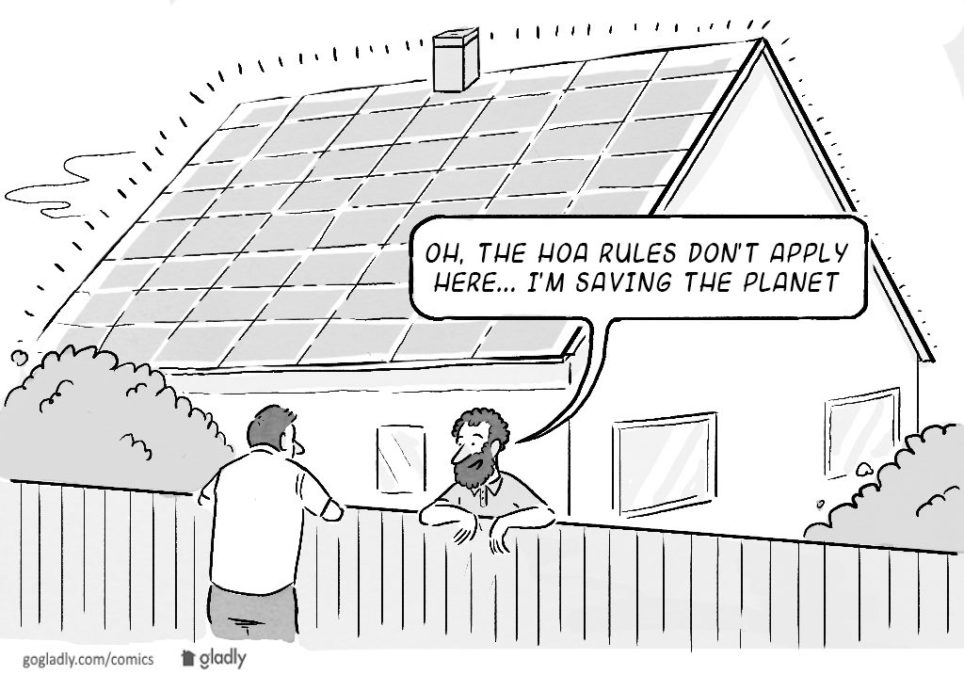Homeowners are increasingly recognizing both the financial and environmental benefits of installing solar panels on their homes and the solar industry is booming. You may be considering the benefits yourself; but, if you live in or serve on the board of a homeowners association, beware of some important pitfalls before you go solar.
Failing to carefully think through the complexities of solar panels in HOAs can lead to costly and contentious conflicts. HOAs and their members should consider several important factors before installing or allowing others to install solar panels.
Solar Statutes
More and more states are adopting laws to allow homeowners to install solar panels, despite what the HOA’s CC&Rs or governing rules may say. For example, many states including, without limitation, Texas, Florida, California, Arizona, Washington, Hawaii, Colorado have all adopted legislation preventing HOAs from broadly banning solar energy systems. The Utah legislature recently considered, but refrained from adopting a solar access law, in part recognizing homeowners right to contract and to self regulate through adoption of their own CC&Rs.
Most solar statutes provide some level of discretion for HOA boards to “reasonably” regulate placement and aesthetics. Such regulations will generally be enforceable so long as they don’t materially decrease the functionality and operation of the system.
As consumer demand for solar panels increases, states without solar statutes, should anticipate the solar lobby pressing for similar legislation expanding solar access rights.
In my experience, sometimes overzealous solar industry salespeople misrepresent or mischaracterize applicable laws. Both homeowners and HOA boards should exercise caution and skepticism in relying on legal advice from solar vendors. Adopting an “ask for forgiveness not permission” approach has resulted in costly legal fees for many homeowners who fail to abide by HOA rules and architectural guidelines.
Professional and reputable solar companies encourage homeowners to work with not against the HOA and to comply with enforceable architectural guidelines and HOA rules.
Concerns with Common Areas
Many homeowners believe solar panels are an eyesore in the community, and sometimes the most ideal location for energy absorption is the least aesthetically pleasing. Consumers often purchase within a homeowners association specifically for the aesthetic benefits and stringent architectural controls.
Additionally, homeowners exploring the pros and cons of going solar often carefully evaluate the location and placement of the panels to maximize sun exposure. In fact, this year, Google announced “Project Sunroof”, which is an online tool which enables homeowners to more accurately predict sun exposure based on Google’s aerial mapping.1 Thus, areas of maximum sun exposure can become an area for conflict and competition. Homeowners living in a townhome or condominium with common and shared roofs compete for locations with ideal sun exposure. Accordingly, HOAs should carefully craft a policy to fairly and equitably allow access to common roofs and common areas.
When roof space is inadequate, homeowners get creative and place panels on masts or brackets out of landscaped yard area. Sometimes owners elevate panels from the surface of the roof to capture more sunlight. As panels are elevated beyond roof lines and placed further from the unit or building, more wires, conduits and brackets are required, all of which can create unsightly conditions, and give rise to complaints from neighbors. A good HOA solar policy will properly balance maximum energy production and aesthetic and architectural concerns.
Solar Panel systems also create maintenance challenges for HOA maintained common areas. When placed on common roofs or walls, which HOAs are required to maintain, panels may need to be removed to maintain, repair, or replace the roofing or cladding systems. Poor workmanship by solar panel installers can also cause water intrusion and expensive property damage.
HOAs that permit solar panels to be installed on common areas should allocate responsibility for added maintenance and resultant property damage. A conversation and handshake are not enough. In order to ensure such allocation agreements are predictable and enforceable for current and subsequent owners, these agreements should be in writing and recorded as covenants running with the property.
Conclusion
While solar power has been available for many years, the availability and affordability of modern solar energy systems has recently piqued consumer interest throughout the county. While there are certainly environmental and financial benefits, there are also many challenges presented in the context of a community association. HOAs should seek counsel from qualified industry professionals and attorneys to prepare careful policies to balance the competing interests.
- Vacation Rentals in Your HOA - September 25, 2017
- Solar & HOAs — Who Has The Power? - June 15, 2016
- Is Construction Defect Litigation All It’s Cracked Up to Be? - November 3, 2015



 Help
Help